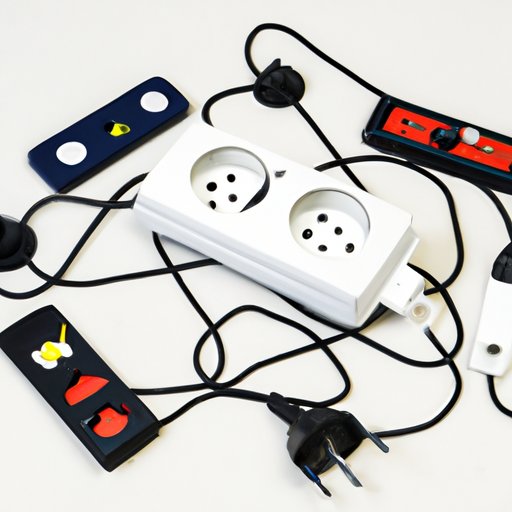
Introduction
Power strips and surge protectors have become essential electrical equipment in modern households, offices, and businesses. They provide additional outlets for electronic devices and protect them against power surges and electrical fires. However, many people are unaware of the potential dangers of plugging a surge protector into another surge protector or power strip, a practice known as daisychaining.
This article explores the dos and don’ts of power strips, the hazards of daisychaining, and the best practices for using and maintaining surge protectors and power strips.
The Dos and Don’ts of Power Strips: Why You Should Never Plug a Surge Protector into Another
A power strip is an electrical device that comprises multiple outlets, often with a circuit breaker or surge protector. A surge protector is a kind of power strip that has additional features to protect devices plugged into it against power surges and voltage spikes. The purpose of a surge protector is to regulate the electrical current and prevent excess voltage from reaching sensitive electronic devices.
However, plugging one surge protector into another or a power strip is not recommended and can have serious consequences.
Fire Hazard Alert: Why You Should Avoid Daisychaining Surge Protectors
Daisy chaining is the practice of plugging multiple power strips or surge protectors into one another to extend their reach or create more outlets. While it may seem like a convenient solution, daisychaining can cause serious electrical hazards, often leading to fire outbreaks.
When you plug a surge protector into another, you’re essentially compromising its ability to regulate voltage and protect against power surges. Additionally, overloading the outlets with too many devices can cause them to overheat and ignite surrounding flammable materials like carpets, curtains, or furniture.
Power Strip Safety Tips: Understanding the Risks of Plugging a Surge Protector into Another
To avoid the dangers of daisychaining, there are essential safety tips that you should follow when using power strips and surge protectors.
- Only plug one surge protector into a wall outlet.
- Do not plug one surge protector into another or a power strip.
- Do not overload the outlets with too many devices.
- Make sure the total electrical current of the devices plugged in does not exceed the power strip’s limit.
- Pay attention to the manufacturer’s guidelines and specifications for the power strip or surge protector you’re using.
- Unplug devices that are not in use.
- Replace old or damaged surge protectors immediately.
By following these tips, you’ll reduce the risks of electrical fire, damage to your devices, and personal injury.

The Ultimate Guide to Surge Protector Usage: How to Properly Use and Avoid Misuse
Surge protectors come in different types, ratings, and features. To choose the right surge protector for your devices, you need to consider a few factors.
A surge protector’s rating indicates the maximum amount of voltage it can handle before tripping the circuit breaker or shutting down. The higher the rating, the better the protection. Ideally, you should choose a surge protector with a rating of at least 600 joules or higher.
Additionally, you should consider the number and type of outlets, the durability of the device, and any additional features like USB ports or phone jacks.
Once you’ve purchased a surge protector, you need to install and use it correctly. Here’s a step-by-step guide:
- Plug the surge protector directly into a wall outlet. Do not use an extension cord or power strip.
- Make sure the device is grounded correctly. Surge protectors often come with a ground fault circuit interrupter (GFCI) that detects electrical imbalances and cuts off the power supply immediately.
- Plug your devices into the surge protector’s outlets. Avoid overloading the outlets and exceeding the device’s current limit.
- Test the surge protector periodically to ensure it’s still functioning correctly.
The Hidden Danger of Connecting Power Strips: What You Need to Know about Electrical Overload
Electrical overload occurs when you plug too many devices into one power source, causing it to exceed its capacity. Overloading can damage your electronic devices, create fire hazards, and lead to electrical failures. Therefore, it’s essential to recognize the signs of electrical overload and how to prevent it.
Some of the signs of electrical overload include flickering lights, frequently tripping circuit breakers or fuses, and buzzing or sparking from outlets. To prevent electrical overload, you should:
- Avoid using too many devices on one circuit
- Distribute the devices evenly across different outlets and circuits
- Learn the power requirements of your devices and use power strips or surge protectors with enough wattage to support them
- Unplug devices that you’re not using, and avoid leaving them on standby mode
- Regularly inspect and test your electrical outlets and devices
Surge Protector Best Practices: Keeping Your Home Safe from Power Surges and Electrical Fires
To ensure the safety of your home and devices, it’s essential to implement the best practices for power strip and surge protector usage.
Here’s a summary of the key tips:
- Only plug one surge protector into a wall outlet, and avoid daisychaining
- Do not overload the outlets, and make sure the devices’ sum of electrical current doesn’t exceed the power strip’s limit
- Pay attention to the manufacturer’s specifications and guidelines for the power strip or surge protector you’re using
- Unplug devices that you’re not using, and replace old or damaged surge protectors immediately
- Choose the right surge protector for your devices, considering the rating, number of outlets, durability, and any additional features
- Install and use surge protectors correctly, and test them periodically
- Be aware of the signs and risks of electrical overload, and take steps to prevent it
By following these best practices, you’ll minimize the risks of power surges, electrical fires, and damage to your devices.
The Truth About Daisy Chaining Power Strips: Debunking Common Misconceptions
Despite the risks involved, some people still believe that daisychaining is a safe and convenient way to solve their power needs. Here are some common myths and misconceptions about daisy chaining, debunked:
- Myth: I can daisychain my surge protectors as long as I don’t exceed the wattage limit
- Fact: Wattage is only one factor in power surge protection. Daisychaining surge protectors can reduce their efficiency and create fire hazards.
- Myth: Power strips and surge protectors are interchangeable
- Fact: Surge protectors are designed to provide a higher level of protection than power strips and should not be used interchangeably.
- Myth: Daisychaining is a cost-effective way to add more outlets
- Fact: Daisychaining can result in costly damages to your devices and property, not to mention potential medical expenses for injuries sustained in electrical fires.
Conclusion
Power strips and surge protectors are crucial for protecting our electronic devices and preventing electrical fires. However, their misuse can be hazardous to our safety and property.
By following the best practices outlined in this article, you can minimize the risks of electrical hazards and create a safer environment for your home or office.
Remember to use the right surge protector for your devices, avoid daisychaining power strips and surge protectors, pay attention to the manufacturer’s guidelines, and unplug devices you’re not using.
Together, we can ensure that using power strips and surge protectors is as safe and effective as possible.
Call to Action
If you found this article helpful, share it with your friends and colleagues to spread awareness of power strip and surge protector safety. Let’s ensure that everyone knows the dos and don’ts of using these essential electrical devices.





